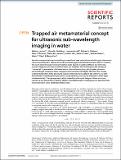Files in this item
Trapped air metamaterial concept for ultrasonic sub-wavelength imaging in water
Item metadata
| dc.contributor.author | Laureti, Stefano | |
| dc.contributor.author | Hutchins, David A. | |
| dc.contributor.author | Astolfi, Lorenzo | |
| dc.contributor.author | Watson, Richard L. | |
| dc.contributor.author | Thomas, Peter J. | |
| dc.contributor.author | Burrascano, Pietro | |
| dc.contributor.author | Nie, Luzhen | |
| dc.contributor.author | Freear, Steven | |
| dc.contributor.author | Askari, Meisam | |
| dc.contributor.author | Clare, Adam T. | |
| dc.contributor.author | Ricci, Marco | |
| dc.date.accessioned | 2020-07-13T15:30:01Z | |
| dc.date.available | 2020-07-13T15:30:01Z | |
| dc.date.issued | 2020-06-30 | |
| dc.identifier | 269040667 | |
| dc.identifier | 698755f5-1041-4049-91ee-2951f5bc0314 | |
| dc.identifier | 85087115899 | |
| dc.identifier | 000548353500001 | |
| dc.identifier.citation | Laureti , S , Hutchins , D A , Astolfi , L , Watson , R L , Thomas , P J , Burrascano , P , Nie , L , Freear , S , Askari , M , Clare , A T & Ricci , M 2020 , ' Trapped air metamaterial concept for ultrasonic sub-wavelength imaging in water ' , Scientific Reports , vol. 10 , 10601 . https://doi.org/10.1038/s41598-020-67454-z | en |
| dc.identifier.issn | 2045-2322 | |
| dc.identifier.uri | https://hdl.handle.net/10023/20239 | |
| dc.description | Funding for this work was provided through the UK Engineering and Physical Sciences Research Council (EPSRC), Grant Numbers EP/N034163/1, EP/N034201/1 and EP/N034813/1. | en |
| dc.description.abstract | Acoustic metamaterials constructed from conventional base materials can exhibit exotic phenomena not commonly found in nature, achieved by combining geometrical and resonance effects. However, the use of polymer-based metamaterials that could operate in water is difficult, due to the low acoustic impedance mismatch between water and polymers. Here we introduce the concept of “trapped air” metamaterial, fabricated via vat photopolymerization, which makes ultrasonic sub-wavelength imaging in water using polymeric metamaterials highly effective. This concept is demonstrated for a holey-structured acoustic metamaterial in water at 200–300 kHz, via both finite element modelling and experimental measurements, but it can be extended to other types of metamaterials. The new approach, which outperforms the usual designs of these structures, indicates a way forward for exploiting additive-manufacturing for realising polymer-based acoustic metamaterials in water at ultrasonic frequencies. | |
| dc.format.extent | 12836470 | |
| dc.language.iso | eng | |
| dc.relation.ispartof | Scientific Reports | en |
| dc.subject | QC Physics | en |
| dc.subject | NDAS | en |
| dc.subject.lcc | QC | en |
| dc.title | Trapped air metamaterial concept for ultrasonic sub-wavelength imaging in water | en |
| dc.type | Journal article | en |
| dc.contributor.institution | University of St Andrews. School of Physics and Astronomy | en |
| dc.identifier.doi | 10.1038/s41598-020-67454-z | |
| dc.description.status | Peer reviewed | en |
This item appears in the following Collection(s)
Items in the St Andrews Research Repository are protected by copyright, with all rights reserved, unless otherwise indicated.

